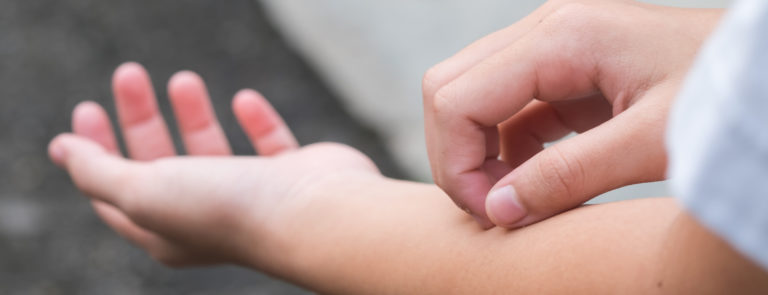20% off €35
Code:HB20
Psoriasis vs eczema: what's the difference?

What’s the difference between eczema & psoriasis? Is there a difference between these two skin conditions? We answer this key question in this article, ‘Psoriasis vs eczema.’
Have you or somebody you know developed a rash on their arm, back or face, or another part of their body, and are wondering what it could be?
You may have found yourself wondering if it’s psoriasis…or maybe it could be eczema? Both psoriasis and eczema can cause itchy red rashes to form, so it could be either of them at first glance.1
But despite the rash similarities, there are some clear indicators that can help you spot psoriasis over eczema, or vice versa. Read on to discover what they are.
The difference between eczema and psoriasis
It’s easy to assume that eczema and psoriasis look the same. They’re both skin conditions….they both look red….they both cause people to break out in a rash…. But that’s how they look on the surface of things. If you spend a bit longer looking at the nature of the symptoms, you’ll soon discover there are some visible differences that are easy to spot (once you know what you’re looking for).Difference #1: Rash types
Psoriasis rashes
Are red patches that may be silvery and scaly and look really raised. But unlike eczema, the skin is actually a lot thicker and more inflamed.Eczema rashes
The skin looks red, inflamed, silvery and scaly, just like psoriasis. The patches can look rough and leathery and sometimes dark. These areas can also swell up too.2Difference #2: Type of itchiness
The itch test
Having itchy red skin is a common symptom of both conditions, but the extent of the itchiness does vary, depending on whether you have psoriasis or eczema. With eczema - the skin is so itchy that it’s possible to scratch yourself until you bleed. With psoriasis - the skin is also itchy, but it also feels like it’s been stung or burnt; almost as though it’s on fire.3Difference #3: Location of symptoms
Generally speaking, both conditions can appear on most parts of the body. However, there are certain areas where you’re more prone to see psoriasis and certain areas you’re more likely to see eczema developing. Eczema tends to develop – on the parts of the body where there are creases. For instance, on your inner elbow or behind your knees. It can also form on your neck, wrists and ankles. Psoriasis tends to develop – on your elbows, knees, scalp and face, lower back, palms of your hands, soles of your feet, mouth and lips, ears, eyelids, fingernails and toenails.4How to seek help for both skin conditions
GPs or dermatologists can usually make a diagnosis based on how the skin looks. In some cases, a biopsy of the skin is carried out.5 In terms of atopic eczema, which is the most common form of eczema, you need to have had itchy skin condition within the last 12 months and experienced three or more of the following symptoms:6- Visibly irritated red skin in the creases of your skin at the time of being examined
- Historically had skin irritations in these areas
- Generally suffered from dry skin over the last 12 months
- Have a history of asthma or hay fever (children under the age of four must have an immediate relative, such as a parent, brother or sister, who has one of these conditions)
- Experienced the condition before the age of two (this does not apply to children under the age of four)
Treating psoriasis and eczema
Unfortunately, there’s no cure for either condition. It’s possible for people living with psoriasis or eczema to see their rashes come and go, and for them to sometimes be really bad, and then at other times, be more manageable.7,8 Meanwhile, some cases of atopic eczema in children can clear up as the child gets older.9Treatments for psoriasis include:
- Corticosteroids (for mild to moderate symptoms)
- Anthralin, coal tar, salicylic acid, Vitamin D cream and topical retinoids (for moderate to severe symptoms)
- Light therapy/phototherapy
- Keeping the skin moisturised
Treatments for eczema include:
- Corticosteroid creams
- Antihistamine creams or tablets, such as Diphenhydramine
- Antibiotic creams
- Light therapy
- Reducing stress
- Avoiding extremely hot temperatures – particularly hot baths or showers
- Moisturising the skin
- Fruit and vegetables - especially berries, cherries and leafy greens
- Oily fish - salmon, sardines, and other fish rich in Omega 3 fatty acids
- Antioxidant-rich herbs and spices – such as thyme, sage, cumin and ginger
- Healthy sources of fat – such as olive oil, seeds, and nuts



